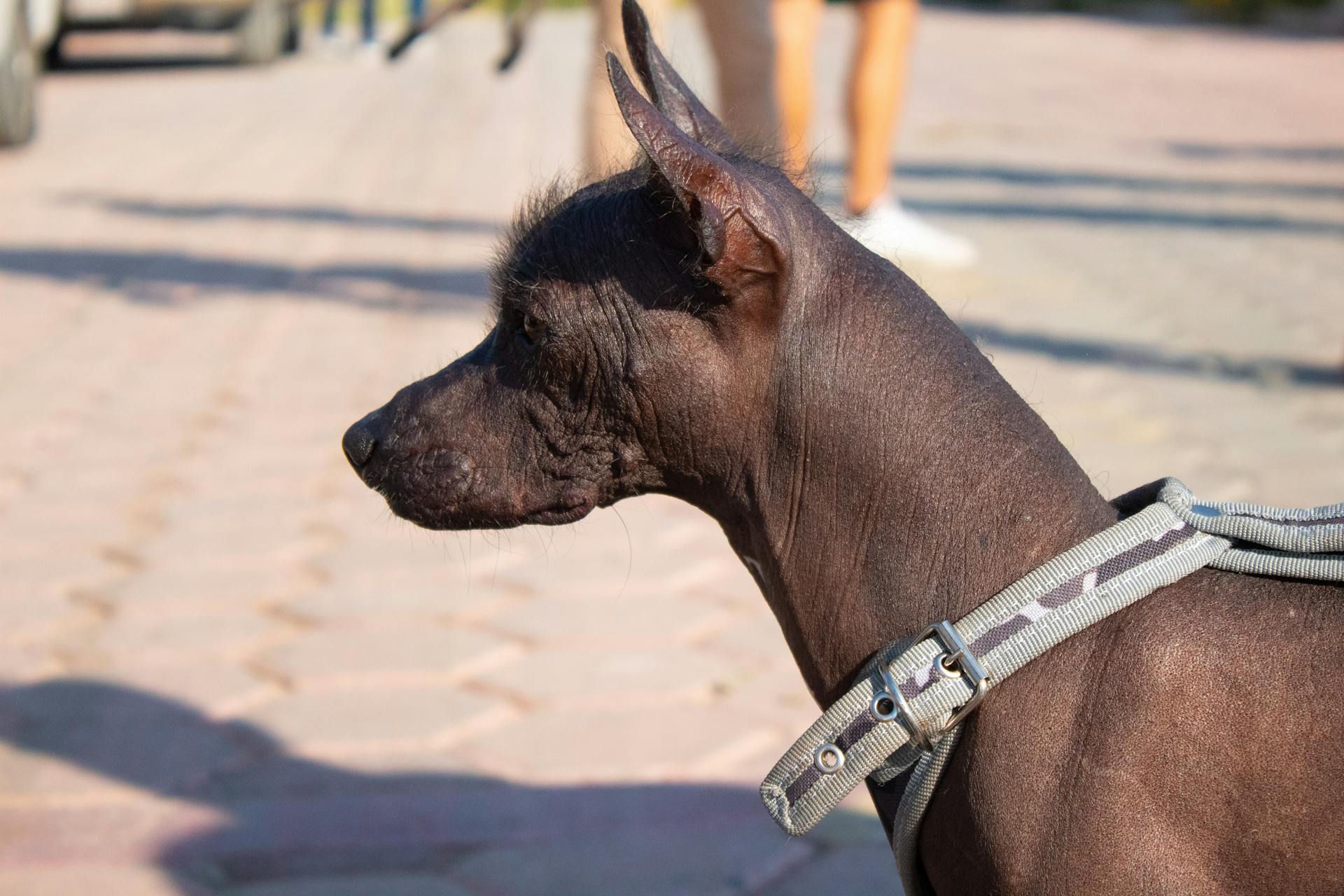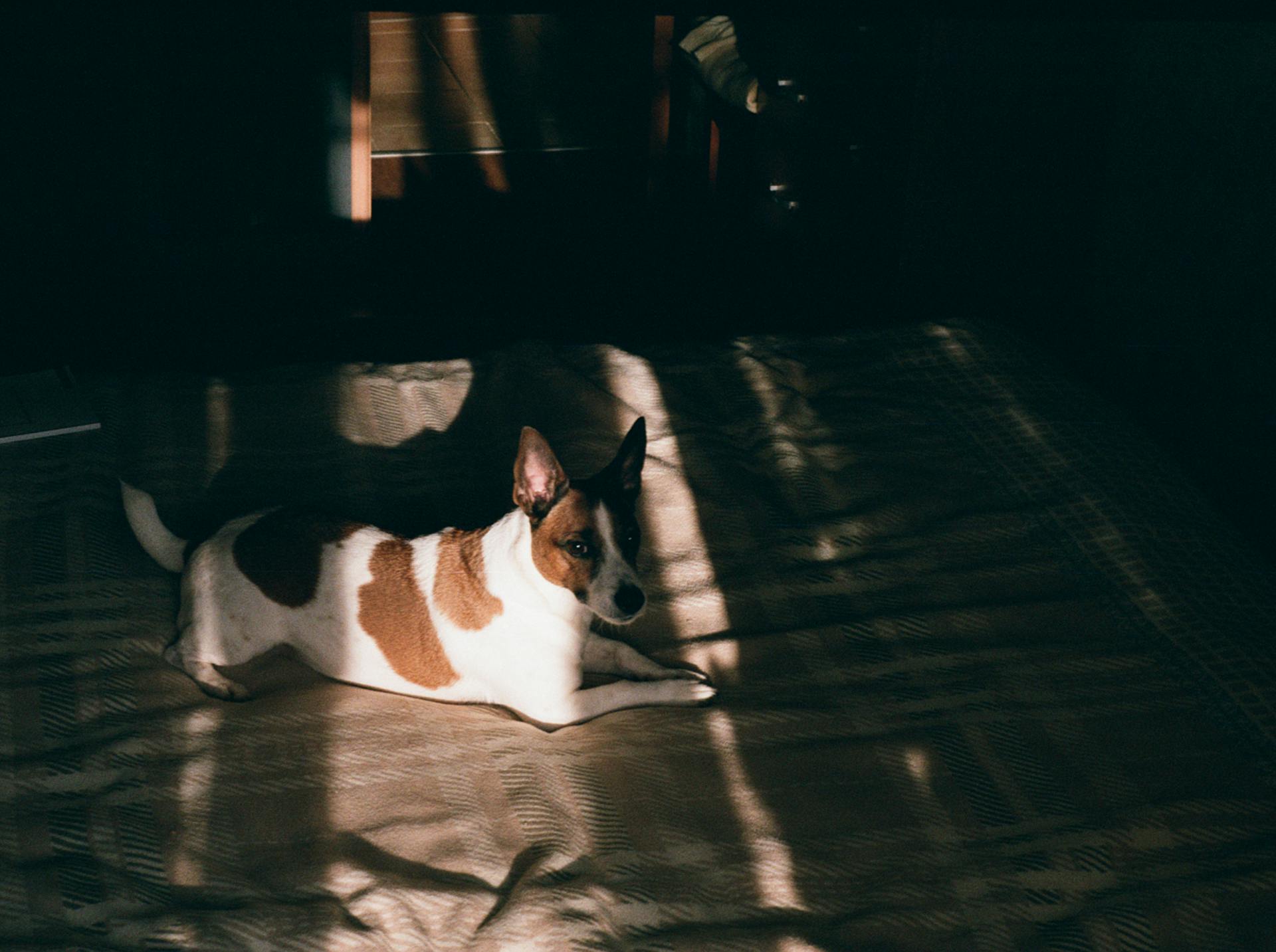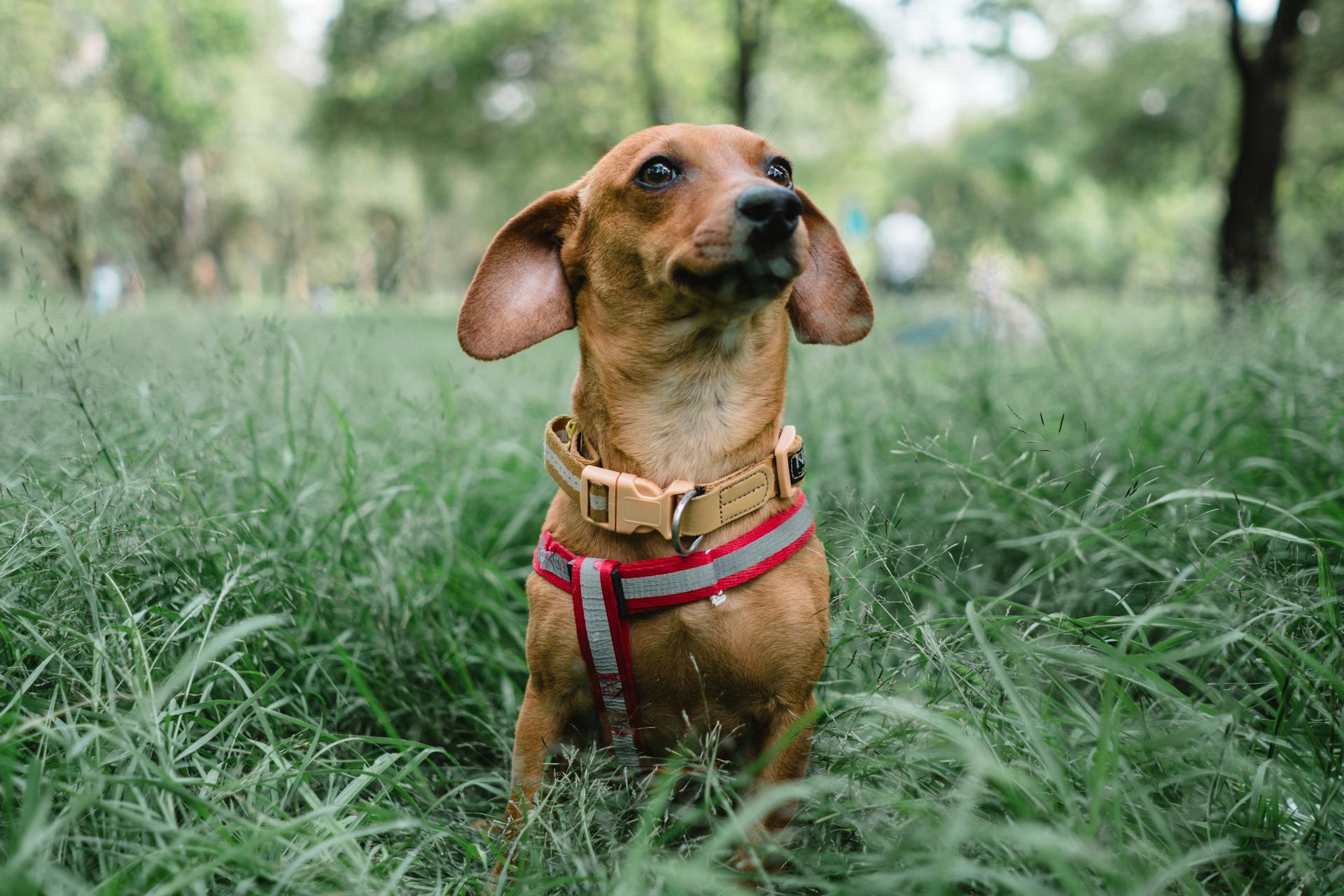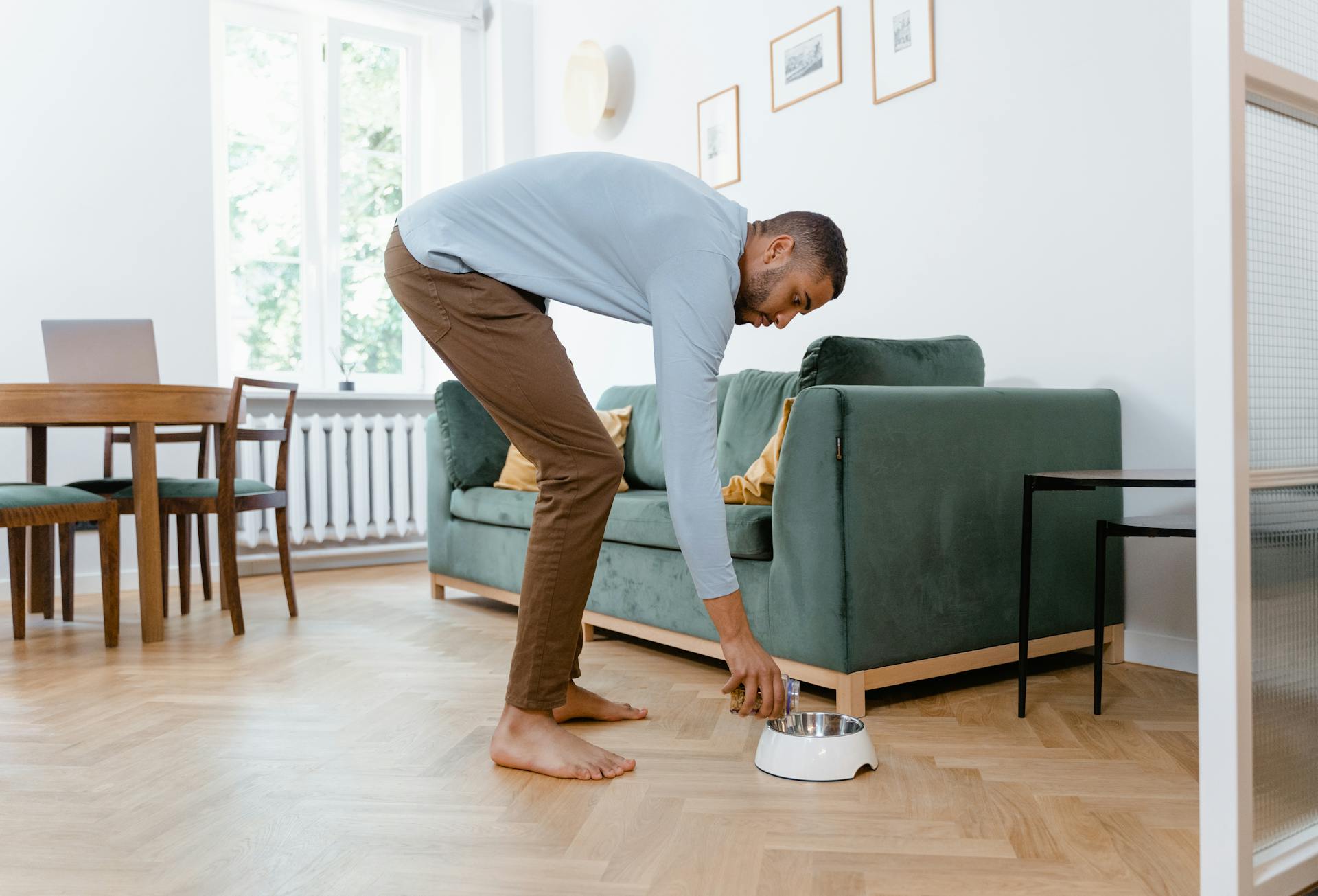
Calm dog aggression requires patience and understanding. According to research, dogs can develop aggression due to underlying medical issues, such as pain or discomfort, which can be addressed through veterinary care.
Recognizing the warning signs of aggression is crucial, as they can be subtle. A growl or snarl can be a sign of impending aggression, and it's essential to take action to prevent escalation.
Dogs are highly attuned to their owner's emotions, and a calm and assertive demeanor can help to diffuse tense situations. By staying calm and in control, you can help to reduce your dog's stress levels and prevent aggression.
Consistency and clear communication are key to addressing dog aggression. By setting clear boundaries and rewards, you can help your dog understand what behavior is expected of them.
You might enjoy: Can Neutering a Dog Help with Aggression
Signs of Aggressive
Aggression in dogs is often rooted in resource guarding or fear, and it's essential to recognize the warning signs to prevent potentially dangerous situations.
Hackles raised and body tense are clear indicators of aggression in dogs. This physical posture can be a sign that your dog is feeling threatened or fearful.
Immediately starting to bark is another common sign of aggression. This behavior can escalate quickly, so it's crucial to address it promptly.
Overreacting to a situation is a sign that your dog is struggling with aggression. This can be a result of fear or resource guarding.
Lunging and snapping are extreme forms of aggression that should never be ignored. These behaviors can lead to serious injuries and are a clear indication that your dog needs help.
Baring their teeth at the perceived threat is a warning sign of aggression that should not be taken lightly. This behavior can quickly escalate to biting.
Here are some common signs of aggression in dogs:
- Growling
- Snarling
- Lunging and snapping
- Baring their teeth
- Biting
Ignoring these warning signs can lead to more serious problems down the line, like biting or other aggressive behaviors. It's essential to address aggression in dogs promptly to prevent these situations.
Calming Your Dog
Pheromone products can be a useful tool in calming your dog's aggression, especially in worst-case scenarios. These products mimic the natural chemicals that animals produce to communicate with each other.
To use pheromone products effectively, introduce them into your dog's environment, such as using a diffuser, collar, or spray. Pheromone diffusers, for example, release a synthetic version of the pheromone that mother dogs produce to calm their puppies.
Here are some examples of different types of pheromone products:
Remember to follow the instructions carefully and use the product as directed. Be patient and consistent when using pheromone products to calm your dog's aggression.
Stiff Body Posture
A stiff body posture is a common sign of aggressive puppy behavior, but it's not always a cause for concern.
It can be a sign of possessive aggression where the puppy feels the need to protect what it thinks of as its own.
However, don't jump to conclusions just yet.
For another approach, see: Are Zoomies a Sign of a Happy Dog
Sometimes, a stiff body posture can simply mean your puppy is feeling curious or extra alert.
To understand what's going on, get to know your puppy's quirks and habits so you can spot the signs of aggressive behavior versus normal dog behavior.
If you notice your dog is stiffening, it may be a sign that they're moving up the aggression scale, which can be a serious issue if not addressed.
This is why it's essential to observe your dog closely for any signs of disturbance.
A professional dog behaviorist, Kendal Shepherd, has identified stages of aggression in canines, and stiffening is one of the early signs.
If this caught your attention, see: Alpha Canine Behavior
Calm Your Puppy
Redirecting attention can be an effective way to calm your puppy's aggression. You can change the environment by taking them to a different room or outside to a new area with different sights, sounds, and smells.
Use a training technique like teaching your puppy to make eye contact with you on command, and then use this technique to redirect their attention when they start to display aggressive behavior.
Related reading: Why Does My Puppy Lick My Older Dogs Mouth
Providing a sensory distraction can also help calm your puppy. You can turn on calming music, use aromatherapy, or provide a textured surface to explore, like a crinkly blanket or a knotted rope.
Physical cues like a gentle pat on the back or a quick tug on the leash can also help redirect your puppy's attention and calm their aggression.
Here are some ways to redirect your puppy's attention:
- Change the environment
- Use a training technique
- Provide a sensory distraction
- Use your voice
- Try physical cues
Timeouts can be an effective way to calm your puppy's aggression, but it's essential to use them correctly. Remove your puppy from the situation immediately, and put them in a designated timeout area. Avoid giving them attention, even if it's positive, as this can reinforce the behavior.
Pheromone products can also help calm your puppy's aggression. These products mimic the natural chemicals that animals produce to communicate with each other and can be used to create a calming environment.
Some signs of protective behavior in dogs include:
- Alert but calm stance
- Focus is on the new person in their environment
- Being constantly vigilant
- Moves between you and the possible threat
- Growls or barks at actual threats or responds appropriately to violence
- Returns to normal if there is no threat
A stiff body posture can be a sign of aggressive puppy behavior, but it's not always a clear indication. Know your puppy's quirks and habits to spot the signs of aggressive behavior versus normal dog behavior.
For your interest: Dog Play Behaviour
Understanding Aggression Causes
Dogs show aggression for many reasons, such as fear, medical issues, and poor early socialization.
Fear is a common cause, making dogs perceive others as threats, even if they're not. This can stem from previous bad experiences or poor early socialization.
Medical issues can also cause behavioral changes, so it's essential to rule out any underlying health problems.
If your dog's behavior has changed with no obvious cause, consult a vet to discuss their behavior, prescribe medication, or refer you to a professional animal trainer.
Discover more: Certified Canine Behavior Consultant
Biting
Biting is a normal behavior in puppies, but it can become aggressive if left unchecked. Puppies bite to explore their environment, learn new things, and play with their littermates.
However, excessive biting can be a sign that your puppy is not comfortable in their environment. If your puppy bites excessively, especially when they're frustrated or afraid, it's a clear indication that they're not feeling secure.
Biting can be a normal behavior in puppies, but it's essential to differentiate it from aggressive puppy behavior. If your puppy's biting becomes aggressive, it's a sign that they're not comfortable in their environment and may resort to aggression to channel their emotions.
Recommended read: Dog Aggression towards Puppies
Here are some signs that your puppy's biting has turned aggressive:
- Excessive biting, especially when they're frustrated or afraid
- Biting in situations where they feel threatened or scared
- Biting in response to frustration or play
It's essential to address aggressive biting behavior in puppies to prevent it from becoming a habit. By recognizing the signs and taking steps to correct the behavior, you can help your puppy develop healthy habits and reduce the risk of aggression.
Dominance Displays
Dominance displays are a clear sign that your dog is feeling dominant and unafraid to show it. These displays can be a warning sign of the dog's aggression.
In the wild, establishing a hierarchy is crucial to a pack's survival and that instinct remains with our domesticated dogs. This means your dog is trying to establish their place in the pack.
Your dog may stand tall over other dogs or push its way through the crowd, engaging in these displays to assert its dominance. Keep an eye on your dog’s behavior patterns during puppy play.
If you notice several of these signs happening at the same time, there's a higher chance of the dog displaying aggressive behavior.
For more insights, see: Dog Pack Mentality Debunked
Determining the Source
Determining the source of aggressive behavior is crucial to effectively managing it. All measures for managing aggressive dog behavior can become void if the main cause of aggression isn’t addressed.
There are many reasons as to why a dog is showing aggressive behavior. One possible reason is a lack of socialization, which can lead to fear and defensiveness in dogs.
Some common causes of aggression include fear, anxiety, and territorial behavior. If a dog feels threatened or scared, it may become aggressive in an attempt to protect itself.
Genetic predisposition can also play a role in aggressive behavior. Some breeds are more prone to aggression due to their breeding history.
Understanding the underlying cause of aggression is key to developing an effective plan to address it. This may involve working with a professional dog trainer or behaviorist to identify the root cause and develop a customized training plan.
Fear
Fear is a common root of aggression in dogs. It can stem from poor early socialization or previous bad experiences.
Dogs who used to have abusive owners are more likely to show aggression due to fear. This can lead to a lifelong pattern of fear-based behavior.
Fearful dogs can perceive other people and dogs as threats, even if that's not the case. They may act to scare others away from themselves and their owners.
Some common signs of fear-based aggression include raised hackles and a tense body. Barking, overreacting, and lunging can also be indicative of fear.
Here are some common signs of fear in dogs:
- Raised hackles
- Tense body
- Immediate barking
- Overreacting to situations
- Lunging and snapping
- Baring teeth at perceived threats
- Biting
Territorial
Territorial aggression is a common issue in dogs, and it's mostly directed towards strangers and sometimes friends when they feel like their space is being invaded. This type of aggression is a natural response to protect their territory.
Dogs tend to show territorial aggression when they feel like their space is being invaded and they have to protect it.
See what others are reading: Why Do Dogs Drool When They See Food
Medical Issues
Medical issues can be a surprising cause of aggressive behavior in dogs. Sometimes, a neurological problem or pain can change a dog's behavior.
If your pet's behavior has changed with no obvious cause, the first step is to rule out medical problems. Your vet can help with this.
A vet can discuss your dog's behavior, prescribe medication, or refer you to professional animal trainers. This is especially helpful if you can't get to a vet in person.
Fluoxetin is an SSRI medication that can be prescribed to help treat aggression in dogs. It can take up to 2-4 weeks to see results.
Common side effects of fluoxetine include sedation, vomiting, decreased appetite, constipation, agitation, and seizures.
Check this out: Vet Dogs Dog Treats
Meet Their Needs
Meeting your dog's needs is crucial to preventing behavioral problems and aggression. Consistently meeting their physical and emotional needs, such as safety, physical health, food, water, exercise, social contact, and mental enrichment, will put your dog in a better state to progress with training.
Dogs have different needs depending on their breed, and meeting these needs will vary accordingly. For example, some breeds require more exercise than others.
Discover more: Will a Female Dog Calm down after Being Spayed
If your dog feels insecure about attention, bored with pent-up energy, or threatened by something, they'll be in a worse state to progress with their training. This can be due to underlying diseases that need to be ruled out by a vet visit.
Meeting your dog's needs is not just about providing the basics; it's also about creating a comfortable and secure environment. A satisfied dog is less likely to exhibit behavioral problems.
Avoiding Triggers
Avoiding Triggers is crucial when dealing with aggressive dog behavior. Competition for resources is a common trigger, which can include food, treats, toys, or attention from owners.
Dogs should be fed, given treats, and played with separately to avoid resource competition. Deny both dogs free access to food, toys, treats, or preferred resting places.
Separating dogs or intervening before they become too excited can help in situations that induce excitement, such as greetings, play sessions, or walks. In some cases, complete separation may be necessary, followed by gradual reintroduction with desensitization and counter-conditioning training.
Common triggers that induce excitement include situations like greeting people, play sessions, walks, car rides, running the property line, or barking at passerby.
A fresh viewpoint: Normal Dog Play vs Aggression
Measuring Your Dog's Aggression
Measuring your dog's aggression is crucial to understanding its causes. A professional dog behaviorist, Kendal Shepherd, introduced the stages of aggression in canines.
Dogs often show early signs of tension, such as nose licking or yawning, looking or turning away, and creeping, which can be easily overlooked by owners.
If these signs are ignored, dogs may escalate to higher levels of aggression, including stiffening, staring, growling, or even biting.
Keep an eye out for these warning signs to address your dog's disturbance promptly and prevent further escalation.
Take a look at this: Signs of Prey Drive in Dogs
Managing Aggression
Relying solely on behavior modification is not enough for protection against aggressive dog behavior. Just like humans, dogs can have an outburst of emotions, making it difficult for them to control their aggressiveness.
Using gates can be an effective way to manage your dog's environment and prevent them from getting too close to triggers of their aggression. You can also use muzzles and leashes to help control their behavior.
If your dog is reactive to strangers or other dogs while walking, it's best to avoid areas where you're likely to encounter them. Walking your dog in quiet, isolated areas can help reduce their stress and anxiety.
Physical barriers can also be used to prevent your dog from accessing you when they're feeling aggressive. For example, you can set up a "place" command to train your dog to retreat to their spot when they're feeling overwhelmed.
Here are some common techniques used to manage aggression:
- Use of gates
- Muzzles
- Leashes
- Physical barriers
- Training a "place" command
Professional Help and Safety
Seeking professional help is a crucial step in addressing dog aggression. A licensed dog behavior consultant can help determine the root causes behind a dog's aggressive behavior.
Before starting any training, it's recommended to consult with a professional dog behavior consultant. They can develop a correct behavior management plan to tackle aggressive behavior triggers.
In severe cases of aggression, re-homing may be necessary if the behavior poses a significant safety issue. Always consult with a veterinarian for more information on this matter.
Aversive citronella spray can be used during dog fights to startle the dogs apart without harming them.
Here's an interesting read: Does Cbd Help with Dog Aggression
Seeking Professional Help
Recognize when your puppy's aggression is beyond your control and requires professional help. A professional dog trainer has the skills and expertise needed to tackle even the toughest cases.
Don't wait any longer to get professional help if your puppy's aggression is becoming too much to handle. Get professional help from a reputable trainer who has experience with all dog breeds and ages.
A professional dog trainer can provide personalized in-home training sessions for puppies that are specially designed to fix aggression and other behavioral issues. These sessions give your pup the focused attention they need to tame its aggressive side.
At-home training sessions allow the trainer to work closely with you and your pup, right in the comfort of your own home. This can be especially helpful if your puppy is anxious or fearful in new environments.
A professional dog trainer will give you customized homework after each training session that will help you and your puppy succeed. This can include exercises and activities to reinforce good behavior and prevent aggression.
For another approach, see: Aggression Dog Trainer
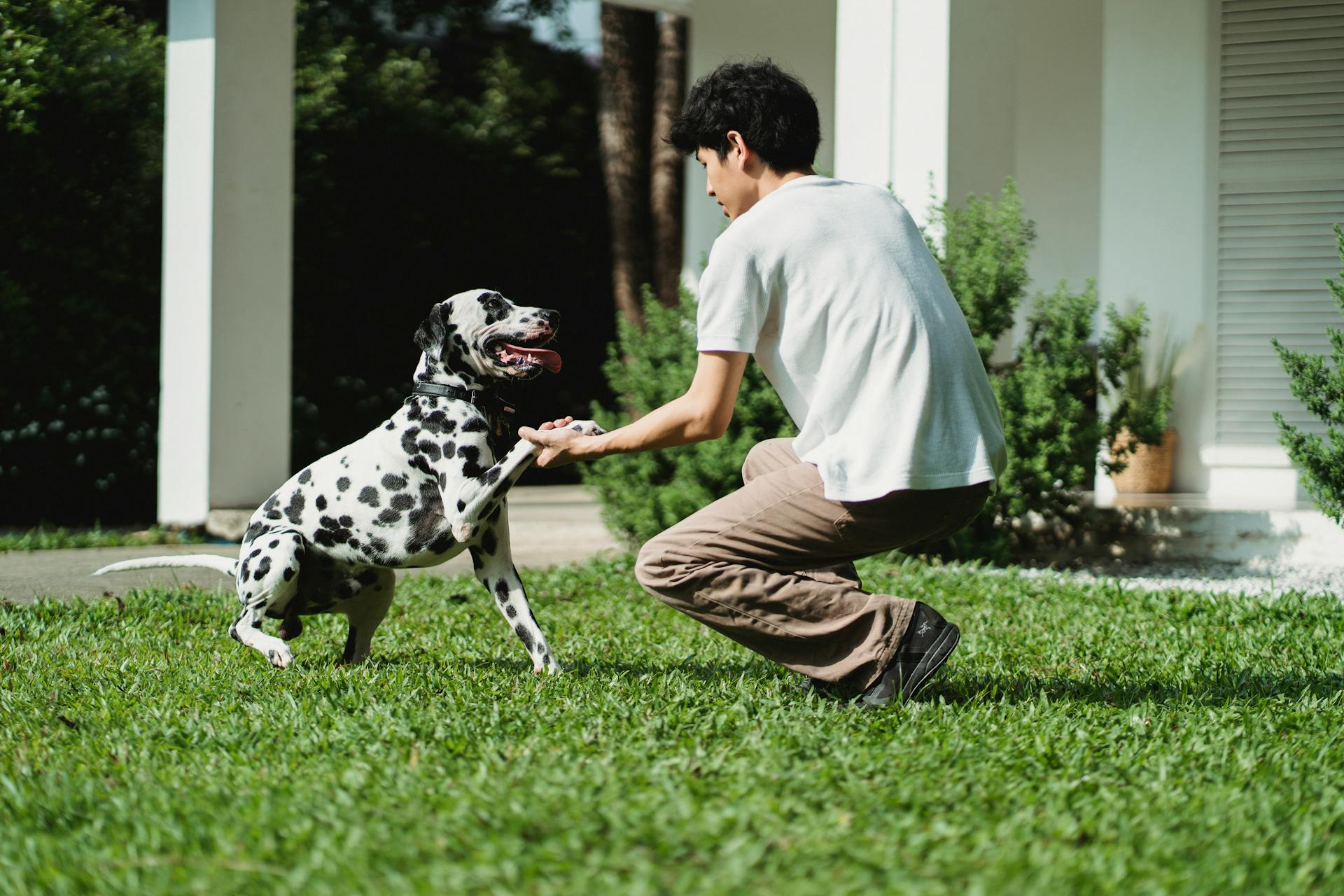
The balanced training method is a powerful technique that combines positive reinforcement with gentle corrections to tackle aggression head-on. This method encourages good behavior while also providing gentle guidance to keep your pup on the right track.
A professional dog behavior consultant can also assist in determining the root causes behind a dog's aggressive behavior. They can develop a behavior management plan to tackle triggers such as fear or stress.
Seeking the advice of a professional dog behavior consultant is a recommended first step before jumping into training. They can help you understand why your pet is behaving aggressively and provide guidance on how to prevent it.
Safety
Safety is crucial when dealing with aggressive dogs, and there are specific tools and precautions you can take to minimize the risk of injury.
Avoiding triggers is essential, but in case of an emergency, a head collar with a trailing leash can be worn by both dogs, allowing you to grab the leashes and separate them easily.
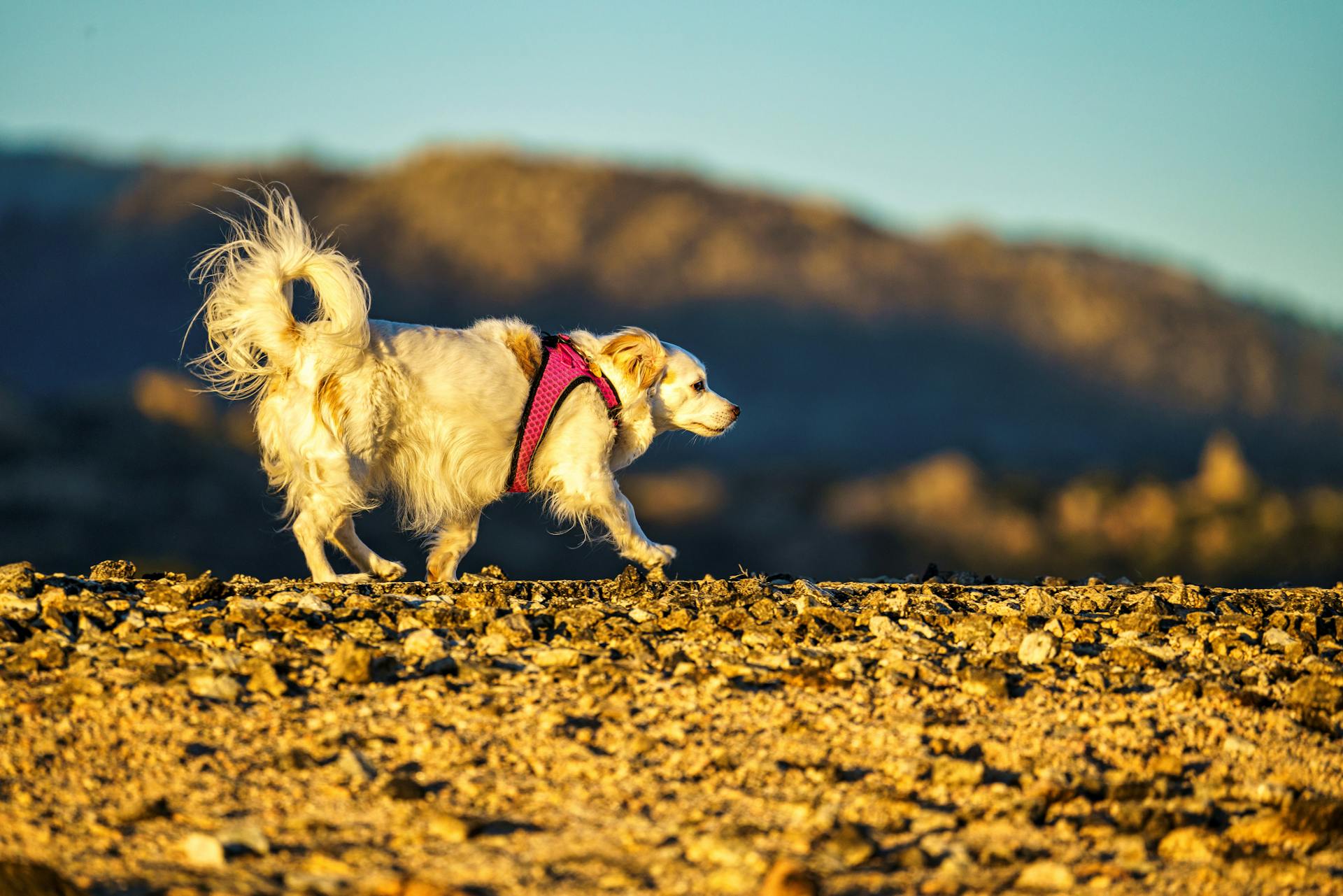
Aversive citronella spray can be used to startle the dogs apart without harming them, but it's essential to consider the severity of the aggression and whether it poses a significant safety issue.
Basket muzzles can be used, as they allow dogs to eat, drink, and pant, but traditional muzzles that close the mouth should not be used.
If fighting is severe, it's best to completely separate the dogs until conditioning and other treatment protocols can be put in place.
Re-homing may be considered if the aggression poses a significant safety issue.
Sources
- https://suburban-k9.com/how-to-stop-puppy-aggression/
- https://www.fitbark.com/blog/10-best-aggressive-dog-training-tips-to-calm-the-beast-down
- https://www.borntoleadk9.com/dog-training-articles/aggression-in-dogs
- https://www.dogster.com/dog-training/how-to-stop-dog-protective-aggression
- https://www.tlcvetelpaso.com/blog/1010-aggression-between-family-dogs
Featured Images: pexels.com
